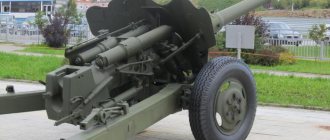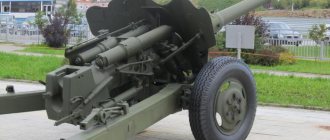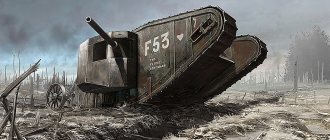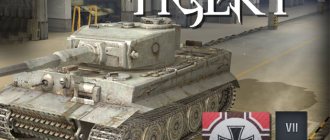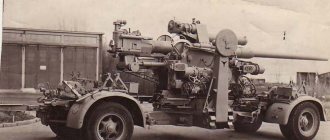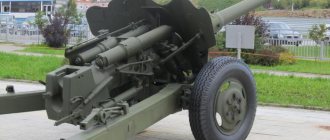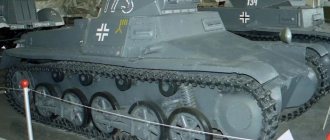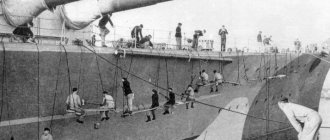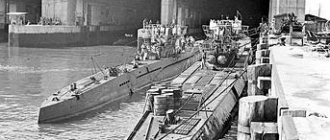photo: youtube.com
After studying the Maginot Line, it became clear to German Wehrmacht (combined armed forces) planners that they did not have weapons capable of penetrating these fortifications. In 1935, the Wehrmacht requested the Krupp factory to prepare ballistic reports for firing 27.6, 31.5, 33.5 and 39.4-inch (70, 80, 85 and 100 cm) shells. A gun was needed that could fire from beyond the reach of enemy artillery and at the same time penetrate 7 m of reinforced concrete or 1 m of steel armor. The plant carried out calculations and provided the requested information, and that was all.
In March 1936, Adolf Hitler visited the plant and asked its director, Gustav Krupp, what weapon could break the Maginot Line. Based on a recent report, Krupp responded that this would require an 80-caliber artillery gun. The corresponding order was given to immediately begin developing such weapons.
In early 1937, Krupp met with Hitler and presented him with a design for a 33.5-inch gun, an artillery gun based on a railway base. Hitler approved the project, and the German army high command commissioned Krupp to build three such guns. The gun was quickly nicknamed Schwerer Gustav (Heavy Gustav) in honor of Gustav Krupp. Hitler wanted the first gun to be ready by March 1940.
Giant Dora Cannon engineering research in the era of war
Gustav had a huge, rifled barrel, which consisted of two halves, the rear half was covered with a casing. The total length of the barrel was 32.4 m, and its cutting depth was 10 mm. A cradle and bolt were attached to the rear of the barrel. Four hydraulic recoil shock absorbers were attached to the cradle. The trunnions held the gun in two huge holders and allowed the barrel to be raised from 0 to 65 degrees.
Each holder was supported by four railroad trucks: two at the front and two at the rear. Each of the eight trucks consisted of five axles, giving Schwerer Gustav a total of 80 wheels that ran along two parallel sections of railroad tracks. The weapon used a diesel generator to power its systems. Schwerer Gustav was 47.3 m long, 7.1 m wide and 11.6 m high. The weight of the barrel, breech and clip was 400,000 kg, and the entire structure weighed 1,350,000 kg.
In addition to parallel paths, the gun needed a path curved by 15 degrees. The weapon had no built-in horizontal aiming capability, requiring the entire mechanism to be moved along a curved path. Additional fastenings were added to prevent damage to the rails due to weapon recoil. Transporting and setting up the Schwerer Gustav for firing required enormous effort.
The weapons were dismantled and delivered on 25 freight cars, excluding crew and supplies. Near the place where the weapons were to be deployed, a direct branch line and three parallel tracks were laid from the main railway line, where Schwerer Gustav assembled. The gun was located on two tracks, and the third allowed the import of parts and equipment. A monorail track was laid on either side of the three parallel tracks for two cranes to assemble the parts and move them into position for assembly.
Nazi tank "Royal Tiger": superweapon or supermyth?
Two parallel paths extended from the assembly point to the firing position. High earthen barriers on either side of the double track were designed to protect the cannon from attack and camouflage it. Schwerer Gustav assembled about 250 people within 54 hours, and from 2,000 to 4,500 people spent weeks laying the necessary paths and preparing the gun's firing position. In addition, two battalions of Flak anti-aircraft guns protected the weapon from air attack.
Krupp built special diesel-electric locomotives to put the Schwerer Gustav into combat position and transport ammunition. The four locomotives, called D 311, were coupled together in twos and operated as a single unit. Each locomotive was equipped with a six-cylinder MAN diesel engine producing 940 hp. (700 kW). Ammunition was delivered on double rails.
A lifting mechanism at the rear of the gun lifted the ammunition onto the firing deck. The shell rose on one side of the gun, and bags of gunpowder and brass cartridges on the other side. A hydraulic pusher loaded the projectile into the barrel, followed by bags of powder charge and cartridge case, after which the loaded gun was raised into firing position. It took from 20 to 45 minutes to load the weapon and get it ready to fire. Only 14-16 shots could be fired per day.
Weight of Dora cannon shells
Schwerer Gustav used two types of shells: armor-piercing (AP) and explosive (HE). AP ammunition was 3.6 m long and required 2100 kg. powder charge. The AP projectile was made of chromium-nickel steel. He weighed 7,100 kg. and carried 250 kg. explosives. Initial speed - 720 m/s, maximum range - 38 km. At its maximum range, the AP projectile reached an altitude of about 12 km. and was in the air for two minutes. HE ammunition was approximately 4.2 m long and required 2240 kg. combat charge. They weighed 4,800 kg. and carried 700 kg. explosives. Initial speed - 820 m/s, maximum range - 47 km. On impact, the HE projectile created a crater 10 m wide and deep. The muzzle velocity of the AP and HE projectiles was more than twice the speed of sound, and both were equipped with an aluminum alloy ballistic nose. Spotter aircraft were used to direct shots and evaluate the results.
Such a powerful weapon as the Schwerer Gustav required a huge amount of resources to create and deploy. Its size and complexity severely limited the time and conditions of use, and also made it vulnerable to air attack.
Construction of the Schwerer Gustav began in the spring of 1937, but the construction of the huge and complex shaft caused serious delays. By 1939, Alfred Krupp took over the management of the company due to his father's deteriorating health. At the end of 1939, tests of component samples began, and the AR projectile was able to successfully penetrate 7 m of concrete and 1 m of steel. It became obvious that Schwerer Gustav would not be fully operational by March 1940, as Hitler had demanded.
In May 1940, Germany invaded Belgium and France. Because the Maginot Line ended in Belgium rather than extending into the English Channel, Germany was able to simply bypass the fortifications. On June 25, 1940, France surrendered to Germany.
KV-2 legendary Soviet heavy assault tank |
After the fall of France, Gustav Schwerer was no longer needed, but discussions ensued regarding other fortifications against which the weapon could be used. Many in the Wehrmacht realized that the weapon was not practical and not worth the resources expended, not to mention the necessary personnel.
However, Schwerer Gustav was one of Hitler's personal projects, so its development continued. Hitler was present at the test firing during acceptance testing of the weapon in early 1941 in Rügenwald, Germany (now Darlowo, Poland). Further testing and development continued until 1941. Some sources indicate that 250 shots were fired during testing.
Hitler's most powerful gun. Super-heavy gun "Dora"
Model of the 800-mm Dora gun.
The largest guns in history
. "Dora" is a unique weapon. The super-heavy 800-mm railway gun was the crowning achievement of the artillery development of the German army during the Second World War. Developed by famous engineers, this weapon was the most powerful artillery weapon in Hitler's arsenal.
As often happened with German weapons during the war, “Dora” shocked the imagination, but the real effectiveness of the weapon, and most importantly, the resources invested in its creation did not justify themselves. In part, the gun repeated the fate of the super-heavy Maus tank. It was a weapon not for war, but for propaganda. And after the war, for encyclopedias, reference books, fiction and popular science literature.
This development is best described by a popular expression that has come down to us from ancient literature: “The mountain gave birth to a mouse.” Hitler and his generals had high hopes for this gun, but the results obtained from using the Dora were negligible.
How did the idea for Dora come about?
The Dora was originally designed as a heavy-duty artillery piece mounted on a railway platform.
The main targets for the 800-mm cannon were to be the French Maginot line of fortifications, as well as the Belgian border forts, which included the famous Fort Eben-Emael. The task of developing a weapon to destroy the fortifications of the Maginot Line was personally set by Adolf Hitler during a visit. This happened in 1936. It is worth noting that we had extensive experience in creating super-powerful artillery since the period of the First World War, so the choice of the developer of the new super-powerful gun was obvious.
Installation of "Dora" at a position in Crimea
An 800-mm artillery gun, throwing shells weighing approximately 7 tons at the target, which was comparable to the weight of light tanks of those years, was supposed to have vertical guidance angles of up to +65 degrees and a maximum firing range of 35-45 kilometers. The technical specifications issued for the creation of the gun indicated that the projectile of the new gun should be guaranteed to penetrate armor plates up to a meter thick, concrete fortifications 7 meters thick and hard soil up to 30 meters.
The work on creating a unique railway gun was led by Professor Erich Müller, who had extensive experience in creating various artillery systems. Already in 1937, she completed the development of a project for a super-powerful gun. In the same year, the military issued an order to the company to manufacture a heavy-duty weapon.
It is worth noting that despite the developed state of German industry, problems were present in it. This included several financial crises that swept through Germany before the war, as well as the effect of restrictions that were in force after the First World War during the existence of the Weimar Republic. German industry systematically disrupted supplies of even small-caliber anti-aircraft artillery, let alone a super-heavy gun, the analogs of which simply did not exist in the world.
"Dora" was completely assembled only in 1941. By that time, the Maginot Line, which its 7-ton shells were supposed to destroy, had long been taken. And Fort Eben-Emael, which before the war was the cause of headaches for German generals, was taken within 24 hours. The main role in this operation was played by only 85 paratroopers who successfully landed in the fort on gliders.
In total, two guns were fully assembled in Germany: “Dora” and “Gustav”. It is believed that the second gun was named after the director of the company, Gustav Krupp. This order cost Germany 10 million Reichsmarks. For this amount it was possible to build 250 15 cm sFH18 howitzers or 20 240 mm K3 long-range guns for the army at once. For the Wehrmacht, these guns would have been much more useful.
The largest artillery crew in history
The heavy-duty railway gun "Dora" was a structure of gigantic size and scale. In all literature, the caliber of the gun is usually indicated as 800 mm, but to be completely precise, the gun had a caliber of 807 mm. The barrel of this cannon alone weighed 400 tons and was 32.48 meters long. The total weight of the entire gun on a specially designed railway platform was 1350 tons.
800 mm gun shell, T-34-85 tank in the background
The total length of the artillery installation was 47.3 meters, width - 7.1 meters, height - 11.6 meters. To better imagine the size of the installation, it can be noted that it was slightly lower than a standard five-story Khrushchev building. Moreover, only the gun barrel weighed more than 8 Soviet KV-1 heavy tanks of the 1941 model.
The shells with which “Dora” was supposed to hit its targets were also huge. The weight of a high-explosive projectile was 4.8 tons, the weight of a concrete-piercing projectile was 7.1 tons. This was comparable to the combat weight of one of the most common pre-war tanks in the world - the famous Vickers Mk E (aka Vickers 6-ton). The firing range of high-explosive shells reached 52 km, and concrete-piercing shells – up to 38 km.
The artillery mount itself was transported to its location exclusively in a disassembled state. At the same time, it was necessary to build a marshalling station at the site where the 800-mm gun was deployed. The first train delivered 43 cars to the deployment station, which carried service personnel and camouflage equipment. This is exactly how many wagons were required when the gun was used in combat for the only time, when it was delivered near Sevastopol in 1942.
The second train consisted of 16 cars, which delivered the installation crane and various auxiliary equipment to the site. The third train of 17 cars delivered carriage parts and workshops to the site. The fourth train, consisting of 20 cars, carried a 400-ton artillery system barrel, as well as loading mechanisms. The fifth train of 10 cars carried shells and charges for firing. In the carriages of the last train, the set air temperature was artificially maintained - no more than 15 degrees.
Equipping the firing position alone took up to 3-6 weeks, and the assembly and installation of the railway artillery installation itself took about three more days. The assembly of the gun was carried out using railway cranes with 1000 hp engines. At the same time, specialists were regularly assigned to the artillery installation, up to 20 civil engineers in total.
The process of loading the heavy-duty Dora cannon
Although the installation was a railway one, it could not move along a regular railway track. The installation could move and shoot only from a specially built double railway track. During the assembly, the result was a giant railway transporter with 40 axles and 80 wheels (40 on each side on a double track track).
More than 4 thousand people were involved in equipping the position and servicing the installation near Sevastopol. This is an unprecedented figure. This, in addition to the immediate crew and people assembling the gun - 250 people, included several thousand workers who equipped the position and carried out excavation and engineering work.
There were approximately 400 people in the attached anti-aircraft division. According to Manstein, the installation near Sevastopol was covered by two divisions at once, armed with 88-mm anti-aircraft guns and rapid-fire 20-mm machine guns. Also, the gun was equipped with up to 500 people from a military chemical unit, which could put up a smoke screen and hide the installation from the eyes of the enemy.
The effectiveness of Dora is in question
The most powerful artillery unit at Hitler's disposal played virtually no role in World War II.
The shooting effect was impressive, but the exhaust was minimal. The dishes on the tables trembled after the shot at a distance of up to three kilometers, but it was almost impossible to achieve direct hits from such a setup at maximum range. It is estimated that near Sevastopol, “Dora” fired 48 standard shells at various fortifications of the besieged city. The shooting took place from June 5 to June 17, 1942. It is believed that only 5 concrete-piercing shells hit the targets (10.4 percent); German observers did not record the fall of 7 shells at all (14.5 percent). According to the recorded 36 projectiles (excluding hits), the spread reached hundreds of meters: overshoots were 140-700 meters, undershoots were 10-740 meters.
"Dora" fires near Sevastopol
Five more shots with experimental high-explosive shells were fired on June 26, the result of these shots is unknown. It is believed that Dora's only successful hit was the destruction of a large ammunition depot hidden in the rocks on the northern shore of Severnaya Bay. The warehouse, located at a depth of 30 meters, was destroyed by one shot; Manstein wrote about this, in particular, in his memoirs after the war.
At the same time, Germany’s top military leadership rated the effectiveness of the gun’s firing at Sevastopol extremely low. Hitler ordered the installation to be used to suppress the forts and coastal tower batteries under the city, but the only tangible result was the covering of the warehouse.
Later, Colonel General Halder, Chief of the Wehrmacht General Staff, summed up the results of using Dora. He called the railway artillery installation a real work of art, but at the same time useless. Fortunately for the USSR, the Germans spent 10 million marks on something that could be used for propaganda purposes, not war. If German factories had produced an extra 250 heavy 15 cm howitzers, then Soviet soldiers on the fronts of the Great Patriotic War would have had a harder time.
According to some reports, “Dora” could have been used a second time during the suppression of the Warsaw Uprising, but this information is fragmentary and episodic. Most likely, the installation was not used near Warsaw, or the effectiveness of its use was zero.
Of the two installations built, only “Dora” took part in combat operations; “Fat Gustav” never fired at the enemy at all. A third unit designed and built with a new 520 mm long barrel, known as the "Long Gustav", was never completed until the end of the war.
